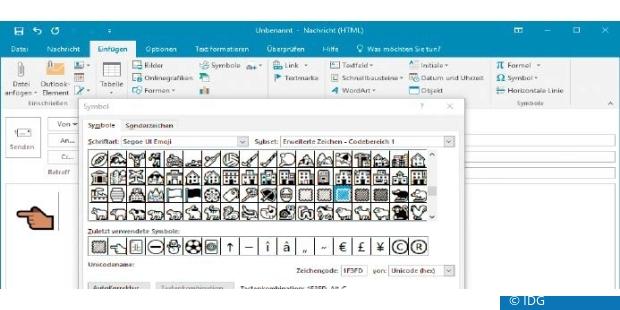Outlook: How to use emojis in mail
That 🙂 becomes a smiley emoji is nothing new. But Outlook has a lot more to offer when it comes to emojis.

Enlarge
The emoji collection in Outlook and Windows allows you to assign a different skin color to human symbols.
Outlook automatically replaces character combinations such as 🙂 with the associated emoji. The symbols come from Windows, which in version 10 uses the current Unicode versions. It is constantly being expanded, an overview of the currently available emojis can be found here.
How to use emojis in Outlook emails
There are several ways to use the symbols in e-mails. The fastest option is to insert emojis via the
Keyboard shortcut [Win+.],
with which the window of the
Windows emojis
opens. Simply select the appropriate emoji there so that it will be integrated into the email.
Another variant is inserting emojis via the
Symbol overview,
which Microsoft has built into Outlook. To do this, proceed as follows:
-
Go to the “Insert” menu, click in the text field to make the commands available, and then select “Symbols> More Symbols”.
-
Set as
font
“Segoe UI Emoji” and as
Subset
one of the three options “Various technical special characters”, “Various symbols” or “Extended characters - code area 1”.
-
The emojis usually appear in a black and white version in the following window; Outlook only switches to the color display when they are inserted. Double-click the symbol to transfer it to your mail.
If you’re using an emoji with a human subject (such as a hand), you can use the
Adjust skin color.
To do this, put the emoji in your message, but keep the Icon window open. Make sure the Extended Characters - Code Range 1 subset is set and scroll down to the five icons that look like patches. You wear that
Character codes 1F3FB to 1F3FF.
Double-click one of them to transfer the color to the first emoji.
Assignment of emojis via a self-defined shortcode
If you want to use an emoji more often, you can assign it a combination of letters so that you can insert it more quickly. To do this, mark the symbol and click on the “AutoCorrect” button. The following window has already taken over the emoji. You now only need to enter a suitable combination of characters to the left under “Replace”.
Example:
They indicate that the word “(sheep)” in brackets is automatically replaced by the corresponding symbol. Finally, confirm with “Add�? and “OK�?.
